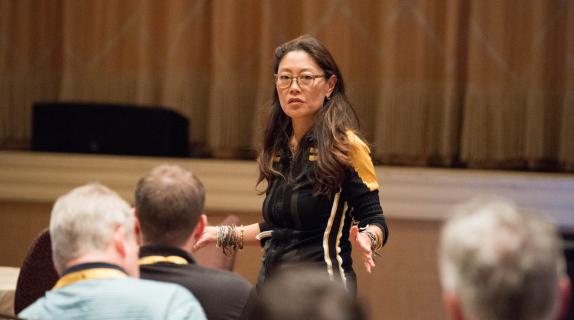Sticking with what you know might not be very effective in growing audiences for local newscasts, TruthCo.’s Linda Ong told TV station executives at Station Summit on Thursday in Las Vegas.
In a workshop titled “The Next News Industry,” Ong said “what I want to help you do is understand how you can nod to people even if you are coming at things from a very traditional point of view. Very often, your digital viewers have different expectations.”
Ong asked a question that’s been prevalent in sessions all week: “What is the point of view of the person I am trying to reach?”
One thing that’s changed drastically since the economic collapse of 2008, is that people feel like things are always out of control.
“The new news viewer is very suspicious of anything that’s coming out of the system. People realize after the collapse that things are not binary. There’s a whole lot of grey and room for layers and complexity. In the past, news has not really dealt with complexity,” Ong said.
These viewers, and particularly the millennial or millennial-minded viewer, have a lot of desire for change.
“Millennials are very fairness-minded and not just for themselves but for everyone,” said Ong. “And millennial ideas don’t stay only with millennials.”
Newscasters serve this audience by reporting on change, and considering that factor when selecting stories.
A big change that news producers must deal with is that they are no longer the only game in town by a longshot.
“Information is a firehose,” said Ong. “Consumers don’t need to be empowered with information. They are kind of over-empowered right now. The role of news in the digital age is really about offering viewers a tool for living.”
Viewers want to know “if I’m going to watch a 6:30 p.m. broadcast, how will that affect my life? How will that make me a better citizen?”
Moreover, by the time it’s time for the evening news, most people have most of the headlines. What they need when they get back home is context and understanding.
“We look to news how to really help us understand those headlines and the impact they have on our lives,” said Ong. “The firehose of data means that everything can be everywhere immediately. Most people graze their own sources and assemble their own content stream.
“Consumers are the CEOs of their own content channels.”
To that end, news viewers are no longer looking for news readers, but news explainers – people who can tell them what’s going on in the world. And since these viewers don’t believe that no one is unbiased or neutral, they don’t mind when their information is served with a point of view.
“A lot of research says viewers find the news to be depressing,” said Ong. “In the drive for ratings, a lot of fear has been deployed in getting people to watch.
“The new news viewer has a desire for the news to play a very different role: that of world explainer.”
People in that role today include ABC’s David Muir, Comedy Central’s Jon Stewart and HBO’s John Oliver.
“John Oliver can do a 15-minute piece unpacking sugar right before Halloween. He makes it fascinating and you learn something,” she said.
A return to shoe-leather, longform, investigative journalism seems to be on the near horizon after several years in which journalism was moving more toward BuzzFeed and Twitter. But as Oliver pointed out in his sugar piece, viewers can only live on empty calories for so long.
“Someone like Anthony Bourdain is actually performing a lot of roles that a journalist would do,” said Ong. “He asks questions, tests hypotheses, tries to learn about the world. He’s owning his point of view. He’s very clear. He’s not trying to be neutral.”
“David Muir is taking people on his journey. He’s going to show you the world as he sees it. It’s a search for truth and everyone can have their own search,” she said.
New news viewers, millennials, truth seekers respond to that sort of authenticity. They are more interested in someone telling their own true story from his or her point of view than listening to a traditional newscast read the news from a teleprompter.
“If your talent is tweeting, people actually want to know what they are having for breakfast. Is this someone I trust because I know who this person is?” said Ong. “It’s really showing who your talent is.”
“That ‘teeth and hair’ look and feel have really been the format of traditional newscasts. You all know that people don’t talk like that and those are all cues to news viewers that you are coming from a traditional mind set,” said Ong.
”The newer voices of authority are real people who don’t look like they’ve been groomed and manicured. Coming from the field is really important. If you have talent like that, you can promote their outsiderness to attract new viewers.”
In the end, Ong left the crowd with some key takeaways:
—If you want to connect with this new viewer, stay away from anything that feels generic. Establish your own identity in a very unique way. You have to find new ways of communicating.
- Go back to shoe-leather journalism and promote that.
—Viewers’ tastes have elevated due to a plethora of choices, and,
—Traditional presentations alienate younger news consumers.
Tags:













































__twocolumncontent.jpg)











